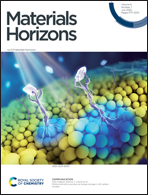An atlas of room-temperature stability and vibrational anharmonicity of cubic perovskites†
Abstract
A soft phonon, which contributes to the strong vibrational anharmonicity and plays an important role in determining the phase stability of materials, is a hallmark of cubic perovskites. The coupling among phonons, charges, orbitals and spins in perovskites has been continuously creating exotic phenomena for new applications. However, a comprehensive overview on room-temperature phase stabilities and vibrational anharmonicites of cubic perovskites is very limited. Here, we use multi-tiered high-throughput computational screening to chart out room-temperature stabilities and vibrational anharmonicity landscapes for the full spectrum of 3819 cubic ABX3 perovskites, encompassing the chemical space of halides, oxides and chalcogenides. We show that halides are systematically more stable and less anharmonic than oxides/chalcogenides. New metrics are developed to quantify the significance of higher order force constants to the strong anharmonicities in room-temperature stable perovskites through both perturbative and temperature-dependent effective potential approaches. The new database and theoretical methods established in this work pave a pathway to deepen the fundamental understanding of lattice dynamics and facilitate the developments of mutifunctional materials with designed physical and chemical properties, such as thermal insulators and high-entropy perovskites.



 Please wait while we load your content...
Please wait while we load your content...